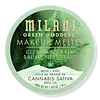What's inside
What's inside
 Key Ingredients
Key Ingredients

 Benefits
Benefits

 Concerns
Concerns

 Ingredients Side-by-side
Ingredients Side-by-side

Ethylhexyl Palmitate
EmollientCarthamus Tinctorius Seed Oil
MaskingCaprylic/Capric Triglyceride
MaskingSorbeth-30 Tetraoleate
EmulsifyingPolyethylene
AbrasivePEG-5 Glyceryl Triisostearate
EmollientCannabis Sativa Seed Oil
EmollientParfum
MaskingDiisostearyl Malate
EmollientPhenoxyethanol
PreservativeTocopherol
AntioxidantSorbitan Sesquiisostearate
EmulsifyingButyrospermum Parkii Butter
Skin ConditioningSqualane
EmollientTriethoxycaprylylsilane
Aluminum Hydroxide
EmollientCI 42090
Cosmetic ColorantCI 19140
Cosmetic ColorantCI 77891
Cosmetic ColorantEthylhexyl Palmitate, Carthamus Tinctorius Seed Oil, Caprylic/Capric Triglyceride, Sorbeth-30 Tetraoleate, Polyethylene, PEG-5 Glyceryl Triisostearate, Cannabis Sativa Seed Oil, Parfum, Diisostearyl Malate, Phenoxyethanol, Tocopherol, Sorbitan Sesquiisostearate, Butyrospermum Parkii Butter, Squalane, Triethoxycaprylylsilane, Aluminum Hydroxide, CI 42090, CI 19140, CI 77891
Ethylhexyl Palmitate
EmollientPolyethylene
AbrasivePEG-20 Glyceryl Triisostearate
EmollientButyrospermum Parkii Butter
Skin ConditioningPhenoxyethanol
PreservativePEG-30 Dipolyhydroxystearate
EmulsifyingSimmondsia Chinensis Seed Oil
EmollientCaprylyl Glycol
EmollientTocopherol
AntioxidantPolysorbate 20
EmulsifyingOctyldodecanol
EmollientPPG-26-Buteth-26
Skin ConditioningTrihydroxystearin
Skin ConditioningCI 42090
Cosmetic ColorantPEG-40 Hydrogenated Castor Oil
EmulsifyingCI 19140
Cosmetic ColorantWater
Skin ConditioningSodium Hyaluronate
HumectantGlucomannan
Skin ConditioningCitric Acid
BufferingEthylhexyl Palmitate, Polyethylene, PEG-20 Glyceryl Triisostearate, Butyrospermum Parkii Butter, Phenoxyethanol, PEG-30 Dipolyhydroxystearate, Simmondsia Chinensis Seed Oil, Caprylyl Glycol, Tocopherol, Polysorbate 20, Octyldodecanol, PPG-26-Buteth-26, Trihydroxystearin, CI 42090, PEG-40 Hydrogenated Castor Oil, CI 19140, Water, Sodium Hyaluronate, Glucomannan, Citric Acid
Ingredients Explained
These ingredients are found in both products.
Ingredients higher up in an ingredient list are typically present in a larger amount.
This ingredient is also known as shea butter. It is an effective skin hydrator and emollient.
Emollients help soothe and soften your skin. It does this by creating a protective film on your skin. This barrier helps trap moisture and keeps your skin hydrated. Emollients may be effective at treating dry or itchy skin.
Shea butter is rich in antioxidants. Antioxidants help fight free-radicals, or molecules that may harm the body. It is also full of fatty acids including stearic acid and linoleic acid. These acids help replenish the skin and keep skin moisturized.
While Shea Butter has an SPF rating of about 3-4, it is not a sunscreen replacement.
Shea butter may not be fungal acne safe. We recommend speaking with a professional if you have any concerns.
Learn more about Butyrospermum Parkii ButterCI 19140 is also known as Tartrazine. Tartrazine is a synthetic dye used in cosmetics, foods, and medicine to add a yellow color.
Tartrazine is created from petroleum and is water-soluble.
Some people may experience allergies from this dye, especially asthmatics and those with an aspirin intolerance.
Learn more about CI 19140Ci 42090 is a synthetic dye created from petroleum. It is used to give a bright blue color to cosmetics, medicine, and food.
Ethylhexyl Palmitate, also known as octyl palmitate, is created from 2-ethylhexyl alcohol and palmitic acid. It is a fatty acid ester.
The fatty acid content of Ethylhexyl Palmitate makes it an emollient. Emollients help soften and hydrate your skin by trapping moisture within.
Ethylhexyl Palmitate is also used to help improve the texture of cosmetics. It helps other ingredient dissolve in products and help disperse ingredients more evenly.
You'll likely find this ingredient in sunscreen, as it is often used to mix UV-blocking ingredients such as avobenzone and ethylhexyl triazone.
It can also help stabilize the fragrances in a product as a fragrance fixative.
Ethylhexyl Palmitate can be used to substitute mineral oil.
Due to its high fatty acid content, it may not be fungal-acne safe.
Learn more about Ethylhexyl PalmitatePhenoxyethanol is a preservative that has germicide, antimicrobial, and aromatic properties. Studies show that phenoxyethanol can prevent microbial growth. By itself, it has a scent that is similar to that of a rose.
It's often used in formulations along with Caprylyl Glycol to preserve the shelf life of products.
Polyethylene is a synthetic ingredient that helps the skin retain moisture. It is a polymer.
It is also typically used within product formulations to help bind solid ingredients together and thicken oil-based ingredients. When added to balms and emulsions, it helps increase the melting point temperature.
Tocopherol (also known as Vitamin E) is a common antioxidant used to help protect the skin from free-radicals and strengthen the skin barrier. It's also fat soluble - this means our skin is great at absorbing it.
Vitamin E also helps keep your natural skin lipids healthy. Your lipid skin barrier naturally consists of lipids, ceramides, and fatty acids. Vitamin E offers extra protection for your skin’s lipid barrier, keeping your skin healthy and nourished.
Another benefit is a bit of UV protection. Vitamin E helps reduce the damage caused by UVB rays. (It should not replace your sunscreen). Combining it with Vitamin C can decrease sunburned cells and hyperpigmentation after UV exposure.
You might have noticed Vitamin E + C often paired together. This is because it is great at stabilizing Vitamin C. Using the two together helps increase the effectiveness of both ingredients.
There are often claims that Vitamin E can reduce/prevent scarring, but these claims haven't been confirmed by scientific research.
Learn more about Tocopherol